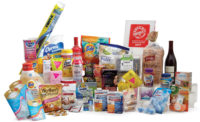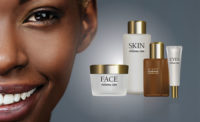Market Trends: Household Packaging
Household care packaging players must focus on design and labeling

Market trends in the three major household care categories.

Hex is one of the first to use a flexible pouch for laundry detergent.

Mondi Group's WPP Box Bag is designed for packaging of powders and granular materials.

The JUPOL Trend line flashes a trendy, fashionable label that JUB says works wonders for brand recognition.

The custom long-neck PET bottle shows vibrant colors, like the fiery red shown, for shelf differentiation and also includes a measuring cup that snaps onto the bottle neck.





Three major household care categories – home laundry products, home surface cleaners and dishwashing products – show little growth in the household packaging industry. Due in part to intense competition, aggressive retail promotion and consumers seeking value, it is up to the package design – and the labeling – to lift sales by differentiating brands and delivering value.
The largest segments account for three quarters of overall sales in the industry: all-purpose cleaners, toilet, tub and tile cleaners and specialized cleaners (drain, glass, oven and so forth), according to Mintel Group Ltd. (mintel.com): Household Care Packaging Trends study.
Rising confidence amongst consumers could bump the market. With household income stable since 2013 and positive signs from the job market, the potential for (a little) freer spending is there. But, with households dwindling in size as kids move out of the house leaving empty-nesters, i.e. less laundry, dishwashing and cleaning needs, it may not matter.
Eco-friendly packaging is still not a top priority to most consumers, claims Mintel. Main concerns are easy to dispense, safe to use and large size accommodation. Just one in five household care product purchasers place environmentally responsible packaging among their top criteria when deciding what to buy. Even less care if the package is refillable.
Labels matter
The aforementioned study reveals that shoppers want to see directions for use on the labeling. They also look for safety warnings and the ingredient list. Product effectiveness or cleaning power is still the most important feature when deciding what to buy, but what does this say about our consumer nation? To be in the game, brands should design labels with simple and clear directions, viewable warnings and ingredients, as well as the subsequent green-friendly claim.
Repackaging – either the whole kit and caboodle or just a label – may be seen as brand-new by consumers. Just a new or refreshed graphic can make a box, can, bottle or pouch pop. Highlighting new product claims and value may boost a struggling package as well. Take a look at just a few products that have been repackaged lately. Vibrant colors, eco-friendly claims and greater value all seem to work for these brands.
Flexible pouches continue to gain strength in the household packaging market, largely based on the unit-dose dishwashing and laundry detergents. Bottles remain in the top two-thirds of sales, but of the remaining options, the flexible stand-up pouch wins. Scent-boosters and refills also claim the pouch as their package choice.
Hex, a specialty laundry brand designed for sports apparel, is among the first to use flexible pouches for liquid laundry detergent. The brand claims a smaller footprint than a regular bottle, that it doesn’t leak, and that the bag provides a unique form factor for a detergent that’s different. This is evident on the labeling. The spigot allows for quick pouring. Just remove foil seal and tear off tab.
Moving forward
Typically each year, though not a top buying concern, eco-friendlier packaging is seen as the number one feature consumers look for. However, they do believe brands should do their part in making their products more enviro-responsible. This belief is another motivator for household companies to make eco-friendly packaging a priority.
Package benefits such as ease of use, low cost and easy storage are main priorities for the consumer. Easy dispensing and safe use are top attention-getters as well. Think: spray, pod or capsule.
Flexible pouches. While flexible packaging may lose some uniqueness as more brands adopt it, flexible pouches may get the stamp of approval for detergent brands moving to more concentrated formulas. Additionally, concentrates and refills could see a push with subscription services and in-store pick up on the rise. Mintel’s “Shopping for Household Care Products – US, July 2015” reveals that interest in online alternatives to traditional in-store shopping is highest among adults in their 20s and 30s.
Go big or go home. Consumers are more apt to purchase larger packages, as they equate larger packaging to greater value. With claims like “20% more” and “50-ounces free,” there’s something to be said about added value.
Bigger households (three or more persons) also buy more than smaller households and are more likely to pay more for value-added features. These include child-safe packaging, functionality and a spill-proof dispenser.
Who’s who. Though admitting they do not recycle, urbanites are more likely to be interested in learning about how to dispose of packaging in a more environmentally responsible way. Consider a green program targeted to rural consumers. [Source: Lightspeed/GMI Mintel]
Hispanic shoppers may be a high-potential market for concentrates and refills. Mintel’s study suggests compact size, the ability to be refilled and eco-friendly packaging are important factors when faced with a purchasing decision.
Millennials (ages 18-34) are more concerned than their older counterparts about environmentally friendly packaging, recyclability and ethical claims; though they are still less likely to recycle. Make sure sustainability features are on the front of the package to keep this group’s interest. They are also brand-centric. In addition to environmental and ethical claims, they look for familiar brands when shopping.
Household products pack a one-two punch
These products have the ingredients necessary for today’s consumer: easy to use, easy to dispense and easy to read ingredient list. A flashy, vibrant label doesn’t hurt either.
Mondi Group’s WPP Box Bag
This tear-resistant woven polypropylene bag has a stable square base, allowing it to stand upright. The WPP Box Bag is designed for packaging of powders and granular materials such as grass seed, cat litter, laundry detergent, sugar and rice. Mondi’s WPP Box Bag has a large area for brand messaging, which can be printed in up to 10 colors. Matte finishes can also be applied. The handle is either die-cut or label. With many sizes available, many easy open and reclose features are in the works.
Berlin Packaging & Weiman Products
Using color psychology, Berlin Packaging’s Studio One Eleven design division designed, engineered and sourced a new stark white bottle for Weiman Products. In the first 12 months after switching its floor cleaning SKUs from lime-green PET tapered bottles to curvy 27-ounce white HDPE packages — and expanding the number of SKUs from two to five — Weiman tripled sales of the line and secured new placements in major chains like Walmart.
RPC Superfos & JUB
The sound of music may be heard through the images on these cans. Sporting bright green, fancy yellow and bold red musical instruments, RPC Superfos got it right with these bright, cheery labels. Slovenian paint producer JUB adopted the plastic paint containers from RPC Superfos for two new interior paint lines. Shown here, The JUPOL Trend line flashes a trendy, fashionable label that JUB says works wonders for brand recognition.
Berlin Packaging & Lube Tech
Berlin Packaging also touts Lube Tech’s Toro bottle with measuring cup for fuel treatment products. The custom long-neck PET bottle shows vibrant colors, like the fiery red shown, for shelf differentiation. It also includes a measuring cup that snaps onto the bottle neck – talk about ease of use. According to Lube Tech, sales have climbed 30%, while reducing material by 16% and cost by 43%.
Looking for a reprint of this article?
From high-res PDFs to custom plaques, order your copy today!











